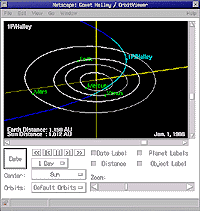Copyright(c) 1996-2001 Osamu Ajiki (AstroArts Inc.)
http://www.astroarts.com/
Copyright(c) 2000-2001 Ron Baalke (NASA/JPL)
http://neo.jpl.nasa.gov/
All Rights Reserved.
 |
 ABSTRACT
ABSTRACT
OrbitViewer is an interactive applet that displays the orbit of small bodies (comets or asteroids) in the solar system in 3D. The orbit may be played forwards or backwards like a movie.
History:
This applet was created by Osamu Ajiki (AstroArts Inc.) in 1996.
It was further modified by Ron Baalke (NASA/JPL) in 2000-2001.
Notice:
AstroArts Inc. will not support this software at all.
But, your suggestions, bug reports are welcome.
Please send e-mail to osam-a@astroarts.co.jp.
 SOFTWARE LICENCE
SOFTWARE LICENCE
This program is free software; you can redistribute it and/or modify it under the terms of the GNU General Public License as published by the Free Software Foundation; either version 2, or (at your option) any later version.
This program is distributed in the hope that it will be useful, but WITHOUT ANY WARRANTY; without even the implied warranty of MERCHANTABILITY or FITNESS FOR A PARTICULAR PURPOSE. See the GNU General Public License for more details.
 HOW TO COMPILE
HOW TO COMPILE
Extract the package with archiver utility which can treat tar ball. If you have UNIX environment, you can do it by the following command:
gzip -dc OrbitViewer-1.3.tar.gz | tar xf -
Now, you have directory named OrbitViewer-1.3, and the directory contains all distributed files.
This package contains executable byte code archive "OrbitViewer.jar", so you don't have to comile it. You need JAVA compiler to compile it yourself. If you have JDK by Sun Microsystems, you can compile it by the following command:
javac OrbitViewer.java
If you have 'make' utility, you can compile it and make jar archive file by the following command:
make
To minimize requirement of runtime environment, and to make it runnable on older version of JAVA compatible WEB browsers, this applet uses only JAVA 1.0 API. The JAVA compiler complains 'deprecated', but I just ignore it.
 HOW TO RUN
HOW TO RUN
You can use JAVA compatible WEB browser or appletviewer to run this applet. If you use WEB browser, open the html file with 'Open File' command of your browser. If you use appletviewer, type as follows:
appletviewer halley.html
This package contains two sample HTML files.
halley.html(Orbit of comet Halley)ceres.html(Orbit of asteroid Ceres)
 PARAMETERS
PARAMETERS
To view orbit of small bodies, you need to know the orbital elements of the object. You can find it on the WEB. (see LINKS)
(1) COMETS
In general, orbital elements of comets are represented by six parameters: time of perihelion passage (T), eccentricity (e), perihelion distance (q), argument of perihelion (omega), ascending node (Omega) and inclination (i). Argument of perihelion, ascending node and inclination have its equinox.
You can display orbit of comet by passing the following parameters to OrbitViewer.
Name: Name of the object T: Time of perihelion passage (T) e: Eccentricity (e) q: Perihelion distance (q; AU) Peri: Argument of perihelion (omega; deg.) Node: Ascending node (Omega; deg.) Incl: Inclination (i; deg.) Eqnx: Equinox (year)
Example for Comet Halley
<APPLET CODE="OrbitViewer.class"
ARCHIVE="OrbitViewer.jar" WIDTH=510 HEIGHT=460>
<PARAM NAME="Name" VALUE="1P/Halley">
<PARAM NAME="T" VALUE="19860209.7695">
<PARAM NAME="e" VALUE="0.967267">
<PARAM NAME="q" VALUE="0.587096">
<PARAM NAME="Peri" VALUE="111.8466">
<PARAM NAME="Node" VALUE=" 58.1440">
<PARAM NAME="Incl" VALUE="162.2393">
<PARAM NAME="Eqnx" VALUE="1950.0">
</APPLET>
(2) ASTEROID
In general, orbital elements of asteroiods are represented by seven parameters: epoch, mean anomaly (M), eccentricity (e), semi-major axis (a), argument of perihelion (omega), ascending node (Omega) and inclination (i). Argument of perihelion, ascending node and inclination have its equinox.
You can display orbit of asteroid by passing the following parameters to OrbitViewer.
Name: Name of the object Epoch: Epoch of the mean anomaly M: Mean anomaly (M; deg.) a: Semi-major axis (a; AU) Peri: Argument of perihelion (omega; deg.) Node: Ascending node (Omega; deg.) Incl: Inclination (i; deg.) Eqnx: Equinox (year)
Example for Asteroid Ceres
<APPLET CODE="OrbitViewer.class"
ARCHIVE="OrbitViewer.jar" WIDTH=510 HEIGHT=460>
<PARAM NAME="Name" VALUE="Ceres(1)">
<PARAM NAME="Epoch" VALUE="19991118.5">
<PARAM NAME="M" VALUE="356.648434">
<PARAM NAME="e" VALUE="0.07831587">
<PARAM NAME="a" VALUE="2.76631592">
<PARAM NAME="Peri" VALUE=" 73.917708">
<PARAM NAME="Node" VALUE=" 80.495123">
<PARAM NAME="Incl" VALUE=" 10.583393">
<PARAM NAME="Eqnx" VALUE="2000.0">
</APPLET>
 DOWNLOAD
DOWNLOAD
OrbitViewer-1.3.tar.gz
 LINKS
LINKS
- Near Earth Object Program - Orbits (NASA/JPL)
- Asteroid Orbit Viewer (AstroArts Inc.)
- Cometary Orbit Viewer (AstroArts Inc.)
- Asteroid Orbital Elements (Lowell Observatory)
- Elements & Ephemerides: Observable Comets (IAU)
- Sky&Telescope January 2001 - Astronomy Online
- Sky&Telescope February 2000 - Astronomy Online
- Centaur Research Project (Robert von Heeren)
- OrbitViewer Invocation for Comets (David James Benn)
- OrbitViewer Invocation for Asteroids (David James Benn)